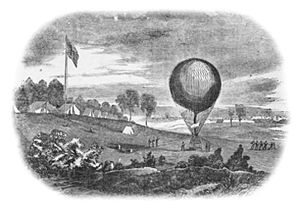 |
| Lowe's Balloon |
SMITHSONIAN INSTITUTION
June 21, 1861.
Hon. Simon Cameron:
Dear Sir: In accordance with your request made to me orally on the morning of the 6th of June, I have examined the apparatus and witnessed the balloon experiments of Mr. Lowe, and have come to the following conclusions:
1st. The balloon prepared by Mr. Lowe, inflated with ordinary street gas, will retain its charge for several days.
2nd. In an inflated condition it can be towed by a few men along an ordinary road, or over fields, in ordinarily calm weather, from the places where it is filled to another, twenty or more miles distant.
3rd. It can be let up into the air by means of a rope in a clam day to a height sufficient to observe the country for twenty miles around and more, according to the degree of clearness of the atmosphere. The ascent may also be made at night and the camp lights of the enemy observed.
4th. From experiments made here for the first time it is conclusively proved that telegrams can be sent with ease and certainty between the balloon and the quarters of the commanding officer.
5th. I feel assured, although I have not witnessed the experiment, that when the surface wind is from the east, as it was for several days last week, an observer in the balloon can be made to float nearly to the enemy’s camp (as it is now situated to the west of us), or even to float over it, and then return eastward by rising to a higher elevation. This assumption is based on the fact that the upper strata of wind in this latitude is always flowing eastward. Mr. Lowe informs me, and I do not doubt his statement, that he will on any day which is favorable make an excursion of the kind above mentioned.
6th. From all the facts that I have observed and the information I have gathered I am sure that important information maybe obtained in regard to the topography of the country and to the position and movement of an enemy by means of the balloon now, and that Mr. Lowe is well qualified to render service in this way by the balloon now in his possession.
7th. The balloon which Mr. Lowe now has in Washington can only be inflated in a city where street gas is to be obtained. If an exploration is required at a point too distant for the transportation of the inflated balloon, an additional apparatus for the generation of hydrogen gas will be required. The necessity of gathering the gas renders the use of the balloon more expensive, but this, where important results are required is of comparatively small importance.
For these preliminary experiments, as you may recollect, a sum not to exceed $200 or $250 was to be appropriated, and in accordance with this, Mr. Lewis has presented me with the inclosed statement of items, which I think are reasonable, since nothing is charged for labor and time of the aeronaut.
I have the honor to remain, very respectfully, you obedient servant,
JOSEPH HENRY
Secretary Smithsonian Institution.
Thaddeus Lowe is one of the great men of science of the 19th century. Henry’s description of the equipment developed by Lowe is a very accurate summation of its capabilities. Lowe made observations at Bull Run in July, but came down behind Confederate lines and barely escaped becoming a prisoner. Lowe’s balloons were used successfully through 1863 when he abandoned his work for the Union over cost cutting measures (including reducing his pay from $10 gold per day to $6 gold). Lowe held numerous patents and developed the water gas process to generate large amounts of hydrogen gas. Lowe is a member of the military intelligence Hall of Fame.
Official Records, Series III, Vol. 3, Page 254.
No comments:
Post a Comment